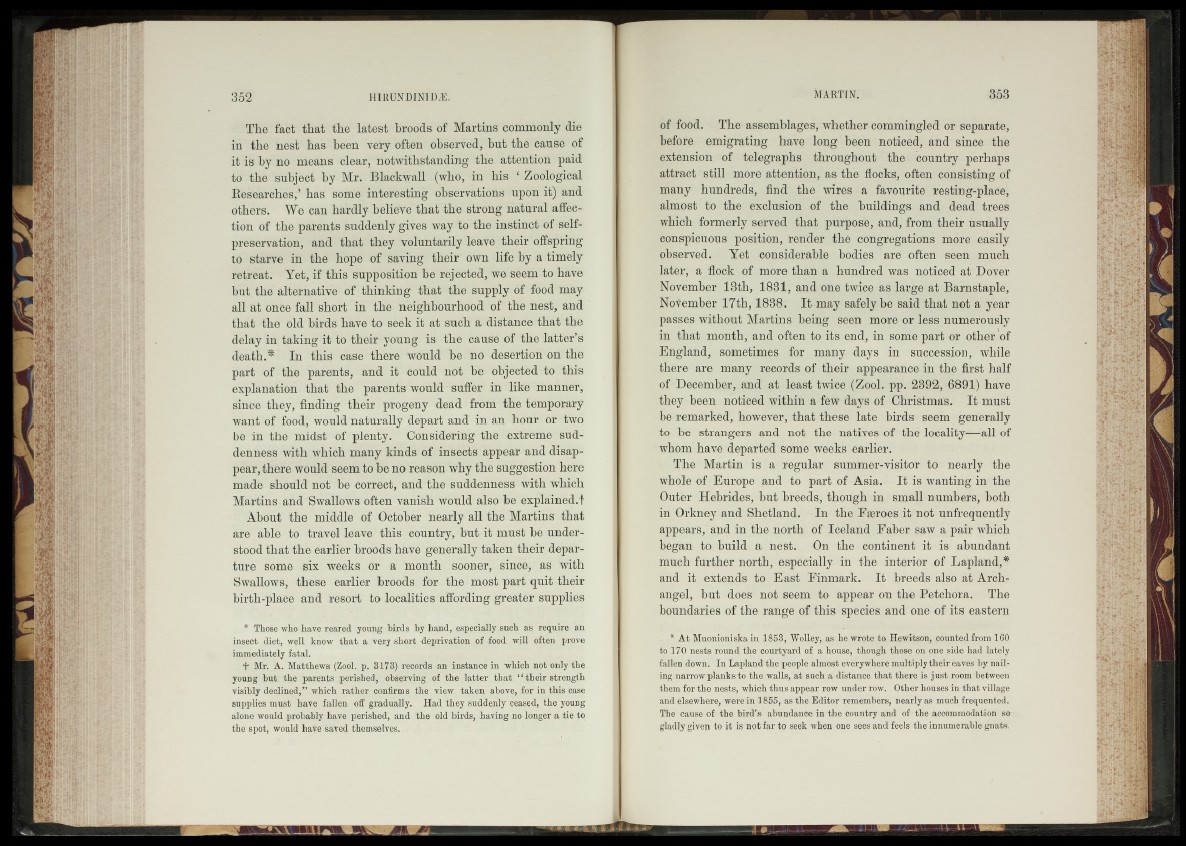
The fact that the latest broods of Martins commonly die
in the nest has been very often observed, but the cause of
it is by no means clear, notwithstanding the attention paid
to the subject by Mr. Blackwall (who, in his ‘ Zoological
Researches,* has some interesting observations upon it) and
others, We can hardly believe that the strong natural affection
of the parents suddenly gives way to the instinct of self-
preservation, and that they voluntarily leave their offspring
to starve in the hope of saving their own life by a timely
retreat. Yet, if this supposition be rejected, we seem to have
but the alternative of thinking that the supply of food may
all at once fall short in the neighbourhood of the nest, and
that the old birds have to seek it at such a distance that the
delay in taking it to their young is the cause of the latter’s
death.* In this case there would be no desertion on the
part of the parents, and it could not be objected to this
explanation that the parents would suffer in like manner,
since they, finding their progeny dead from the temporary
want of food, would naturally depart and in an hour or two
be in the midst of plenty. Considering the extreme suddenness
with which many kinds of insects appear and disappear,
there would seem to be no reason why the suggestion here
made should not be correct, and the suddenness with which
Martins and Swallows often vanish would also be explained.!
About the middle of October nearly all the Martins that
are able to travel leave this country, but it must be understood
that the earlier broods have generally taken their departure
some six weeks or a month sooner, since, as with
Swallows, these earlier broods for the most part quit their
birth-place and resort to localities affording greater supplies
* Those who have reared young birds by hand, especially such as require an
insect diet, well know that a very short deprivation of food will often prove
immediately fatal.
*t* Mr. A. Matthews (Zool. p. 3173) records an instance in which not only the
young but the parents perished, observing of the latter that “ tbeir strength
visibly declined,” which rather confirms the view taken above, for in this case
supplies must have fallen off gradually. Had they suddenly ceased, the young
alone would probably have perished, and the old birds, having no longer a tie to
the spot, would have saved themselves.
of food. The assemblages, whether commingled or separate,
before emigrating have long been noticed, and since the
extension of telegraphs throughout the country perhaps
attract still more attention, as the flocks, often consisting of
many hundreds, find the wires a favourite resting-place,
almost to the exclusion of the buildings and dead trees
which formerly served that purpose, and, from their usually
conspicuous position, render the congregations more easily
observed. Yet considerable bodies are often seen much
later, a flock of more than a hundred was noticed at Dover
November 13th, 1831, and one twice as large at Barnstaple,
November 17th, 1888. It may safely be said that not a year
passes without Martins being seen more or less numerously
in that month, and often to its end, in some part or other of
England, sometimes for many days in succession, while
there are many records of their appearance in the first half
of December, and at least twice (Zool. pp. 2392, 6891) have
they been noticed within a few days of Christmas. It must
be remarked, however, that these late birds seem generally
to be strangers and not the natives of the locality— all of
whom have departed some weeks earlier.
The Martin is a regular summer-visitor to nearly the
whole of Europe and to part of Asia. It is wanting in the
Outer Hebrides, but breeds, though in small numbers, both
in Orkney and Shetland. In the Faeroes it not unfrequently
appears, and in the north of Iceland Eaber saw a pair which
began to build a nest. On the continent it is abundant
much further north, especially in the interior of Lapland,*
and it extends to East Finmark. It breeds also at Archangel,
but does not seem to appear on the Petchora. The
boundaries of the range of this species and one of its eastern
* At Muonioniska in 1853, Wolley, as he wrote to Hewitson, counted from 160
to 170 nests round the courtyard of a house, though those on one side had lately
fallen down. In Lapland the people almost everywhere multiply their eaves by nailing
narrow planks to the walls, at such a distance that there is just room between
them for the nests, which thus appear row under row. Other houses in that village
and elsewhere, were in 1855, as the Editor remembers, nearly as much frequented.
The cause of the bird’s abundance in the country and of the accommodation so
gladly given to it is not far to seek when one sees and feels the innumerable gnats-.